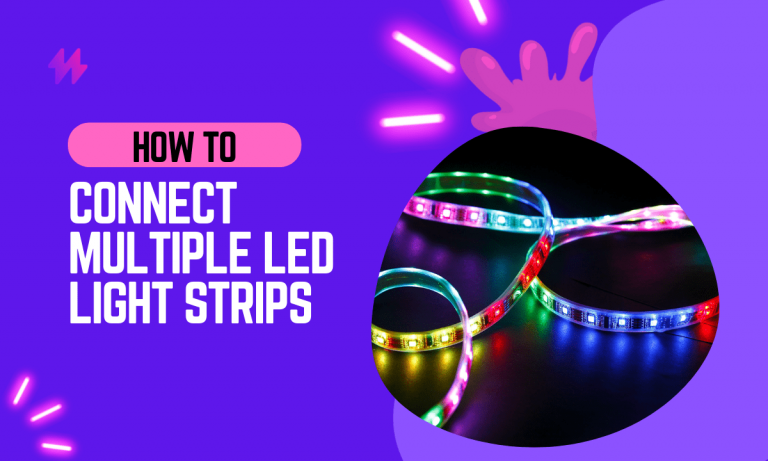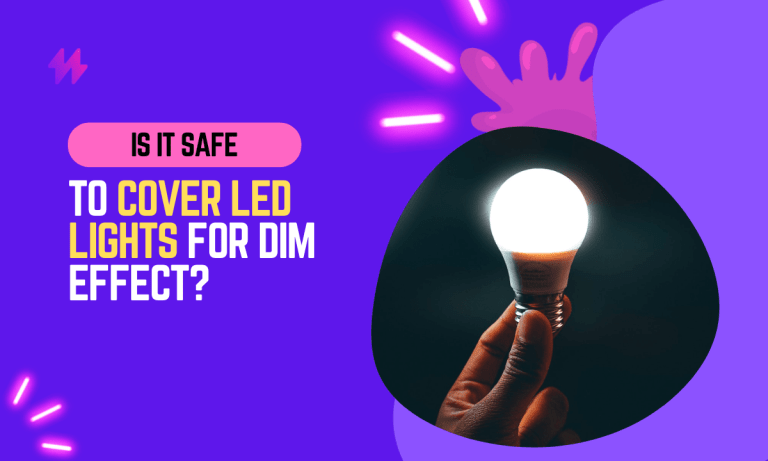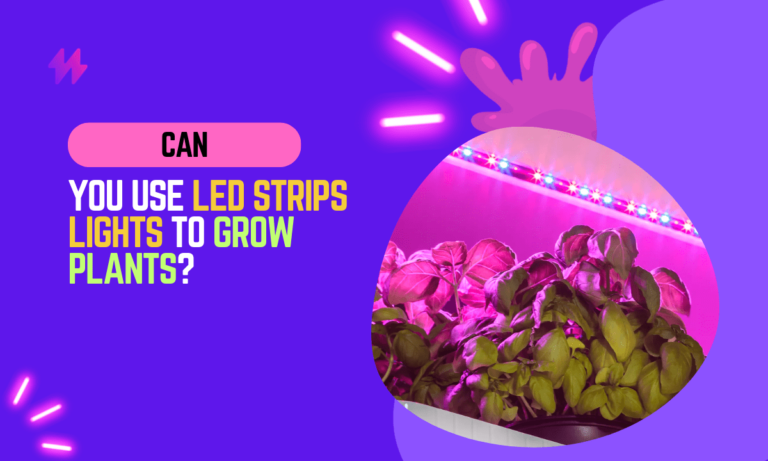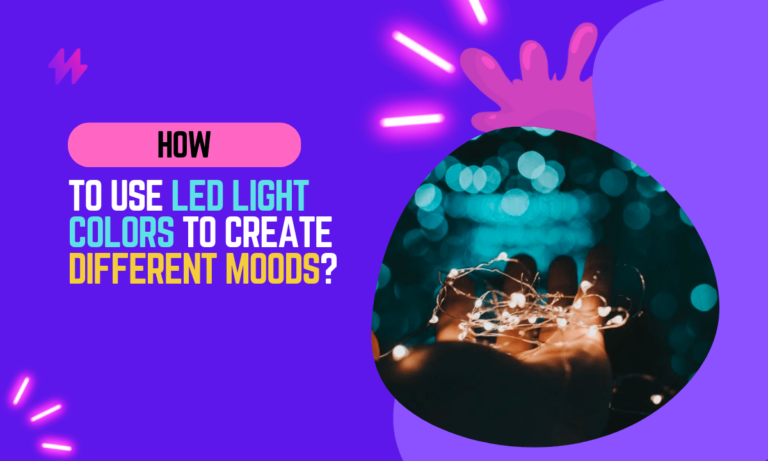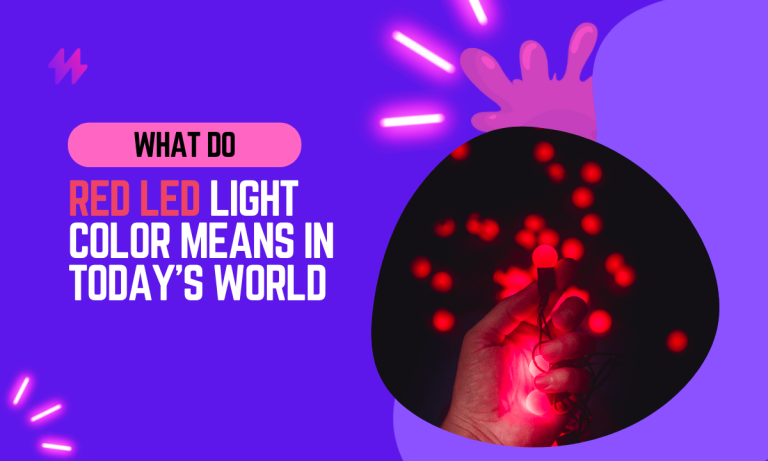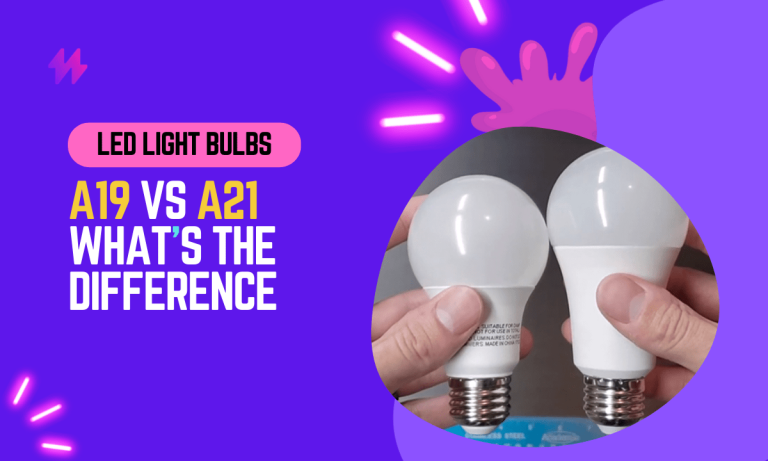How To Sync LED Lights To Music? (3 Methods)

LED lights have been around for a while now and are only getting more popular. LED lights are not just limited to being used as home lighting, they can also be used in creative ways with music. There is a huge range of LED lights to choose from in terms of size, color, and design. Some have the ability to change color or intensity in time with music playing nearby.
In this article, we will explore the various ways to sync LED Lights to music and the benefits of doing so.
LED lights not only enhance home decor but also bring dynamic effects to music experiences, making them a versatile lighting option for any situation. With the right setup, you can easily learn how to sync LED lights to music, utilizing features like music sync technology and audio sensors for an engaging visual display.
How to Sync LED Lights to Music: Various Methods Explained
One of the most popular ways to use LED lights is to sync them with music. This can be done in a number of ways, depending on the type of LED lights and the equipment you have available.
To create a captivating atmosphere, many opt for music sync options with their LED strip lights, effectively transforming any space into a vibrant entertainment zone. By utilizing smart lighting solutions and connecting them to various audio sources, users can enjoy impressive light displays that dance along to the rhythm of the music they love.
How to Achieve Music Sync: Sync LED Lights To Music Using A Controller
If your LED lights come with a controller, then it is likely that they can be synced to music. Most controllers will have a “sound active” mode that can be turned on. This mode will make the lights flash or change color in time with any music that is played nearby.
The benefit of using a controller is that it is usually very easy to set up and does not require any extra equipment. The downside is that you are limited to the features that come with the controller. For example, you may not be able to create specific patterns or color changes.
To maximize the benefits of music sync mode, consider using smart light strips that can easily connect to your audio system. Additionally, incorporating a light controller can provide an enhanced music sync ability, allowing you to enjoy a fun music sync experience while creating the perfect atmosphere for any gathering.
Sync LED Lights To Music: Third-Party Controller Guide
If your LED lights do not come with a controller, then you can buy a third-party controller that will allow you to sync your lights to music. There is a wide range of controllers available, so it is important to choose one that is compatible with your lights.
The benefit of using a third-party controller is that you have more control over the patterns and colors of your lights. The downside is that they can be more expensive than using the controller that comes with your lights.
Using a third-party music control device can significantly enhance the music sync abilities of your LED lights, especially when paired with a strong sound system. Whether you’re looking to enjoy soft music for a cozy atmosphere or to create a cool light show with a loud party playlist, having the right tools like plug-in power adapters and a reliable strip light controller can greatly improve your experience.
Sync LED Lights To Music: DMX Method Explained
DMX is a protocol that is commonly used in the entertainment industry to control lights. If your LED lights have a DMX input, then you can use DMX to sync them to music.
The benefit of using DMX is that it gives you a lot of control over the patterns and colors of your lights. The downside is that it can be more difficult to set up than other methods.
DMX offers a unique way to control LED lights with precision, ensuring a professional touch to your lighting system. For an added level of fun, consider integrating third-party music apps that can work seamlessly with your DMX setup, allowing you to play music while synchronizing the lights to create a visually stunning show.
Syncing LED Lights to Music: A Guide Using an Arduino
If you are familiar with programming, then you can use an Arduino to create custom patterns and colors for your LED lights. This method gives you complete control over your lights but can be time-consuming to set up.
The benefit of using an Arduino is that you can create any pattern or color that you want. The downside is that it can be difficult to set up, especially if you are not familiar with programming.
Creating custom LED light patterns using an Arduino can yield impressive results, especially if you combine it with music sync strip lights for a synchronized experience. However, if programming isn’t your forte, there are plenty of pre-made options like the Lepro RGB music strip that allow you to easily set up your lighting for various settings, such as movie audio or a vibrant entertainment center atmosphere.
Sync LED Lights To Music: A Comprehensive Guide Using A Raspberry Pi
If you are familiar with programming, then you can use a Raspberry Pi to create custom patterns and colors for your LED lights. This method gives you complete control over your lights but can be time-consuming to set up.
The benefit of using a Raspberry Pi is that you can create any pattern or color that you want. The downside is that it can be difficult to set up, especially if you are not familiar with programming.
With the evolution of technology, using a Raspberry Pi for controlling LED strip lighting has become a popular DIY project among tech enthusiasts. By integrating advanced features, such as a built-in sensitivity microphone, users can synchronize their lights with various music sources, including Apple Music or their favorite playlists.
How to Sync LED Lights to Music: Step by Step Guide
Now that we’ve looked at some of the ways to sync LED lights to music, let’s take a look at how to actually do it.
To effectively synchronize your LED lights with music, start by connecting your light fixtures to a reliable power supply, ensuring that the voltage aligns with your specific strip lighting options. Using color-coded wires will simplify the connections and make it easier to manage background noise while incorporating a microphone/internal audio system to capture the music signal for a truly interactive experience.
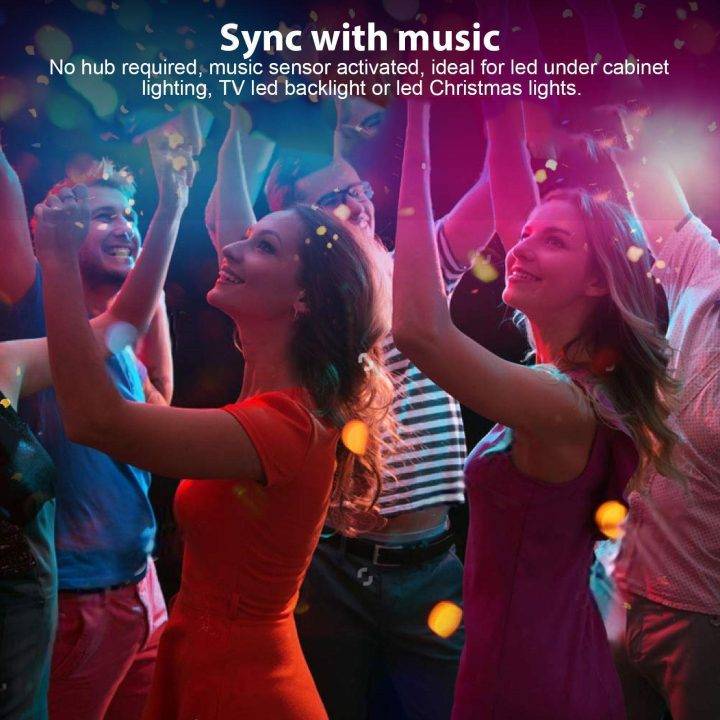
Sync LED Lights To Music: Connect Using A Third-Party Controller
To set up your lights using a third-party controller, follow these steps:
To set up your lights using a third-party controller, follow these steps: First, ensure that your power supplies are compatible with your LEDs and connect the remote control for easy manipulation. Additionally, while using music strip lights such as the Lepro music sync model, you can enhance your experience by exploring the open lit app for various music settings based on your preferred music style.
- Choose a controller that is compatible with your LED lights.
- Connect the controller to your LED lights according to the instructions.
- Turn on the power to your LED lights and controller.
- Select the “sound active” mode on the controller.
- Play some music and watch the lights dance!
Ways to Connect LED Lights to Music: Syncing with DMX
To set up your lights using DMX, follow these steps:
To set up your lights using DMX, follow these steps: First, assess your music/sound source and ensure it is compatible with the DMX system to facilitate synchronization. Additionally, consider incorporating waterproof strip lights for outdoor setups, enabling a delightful ambiance even during events in unpredictable weather.
- Connect your LED lights to a DMX controller according to the instructions.
- Turn on the power to your LED lights and controller.
- Select the “sound active” mode on the controller.
- Play some music and watch your light sync with the music!
Various Methods to Connect LED Lights to Music Using Arduino
To set up your lights using an Arduino, follow these steps:
- Download the Arduino IDE and install it on your computer.
- Connect your LED lights to the Arduino according to the instructions.
- Upload a sketch (a program) to the Arduino that will control the LED lights.
- Turn on the power to your LED lights and controller.
- Play music and watch the lights dance!
You may also like: Soft White vs Daylight Bulbs – 5 Key Differences
To set up your lights using an Arduino, ensure that you’ve gathered the necessary materials, such as keyboards, electrical tape, and a long strip light, to create an engaging installation. You can also program the LED lights to respond to the voice and switch between slow rhythm and vibrant music mode, ensuring a truly interactive and happy lighting experience.
Conclusion: Exploring Various Methods to Sync LED Lights to Music
In conclusion, syncing LED lights to music effectively transforms any space into a dynamic environment, enhancing the audio-visual experience for entertainment, parties, or personal relaxation. The three common methods to achieve this synchronization each offer unique advantages and cater to different user preferences and technical capabilities. The first method involves using LED strip controllers with built-in microphones which automatically respond to sound waves. This option is particularly user-friendly and suitable for casual users who want a quick and straightforward setup without extensive configuration.
The second method is slightly more complex and involves connecting the LED lights to a digital interface or app that allows users to customize how the lights react to different frequencies and beats of the music. This method is ideal for those who prefer a more tailored experience and are willing to engage with more technical setup procedures.
Lastly, for enthusiasts or professional settings, integrating the LED system with a DMX controller presents the most advanced solution. This setup offers precise control over the lighting effects and synchronization, perfect for DJs, event organizers, or theatrical producers who require detailed and programmable lighting arrangements. Whichever method is chosen, the key to successful implementation lies in understanding the specific requirements of the intended use and the technical details of each approach. By doing so, one can enhance the enjoyment and atmosphere of any event or personal space through the vibrant and responsive interplay of light and sound.
How To Sync LED Lights To Music | How to Set Up Your Environment for Syncing LED Lights to Music
Creating the right environment is crucial for achieving a successful sync of your LED lights to music. Start by selecting a location where the lights will be clearly visible and where sound can travel unobstructed. Consider areas near speakers, ensuring that your twinkly music USB is connected properly to the audio source to maximize synchronization effects. The surroundings should be free of distractions that could interfere with the setup and operation of your lights. Properly arranging your LED lights and audio sources enhances the overall experience, making it easier to explore How To Sync LED Lights To Music effectively.
How To Sync LED Lights To Music | Choosing the Right Location for LED Lights
Choosing the right location for LED lights is crucial for effective synchronization with music. A well-thought-out placement can enhance the overall experience by creating a vibrant atmosphere that resonates with the beats. Consider areas where the lights can be seen clearly while ensuring they are positioned to reflect the intended mood and enhance the sound. Properly placed LED lights can significantly contribute to how you perceive the music, making it essential to think strategically about location.
Understanding how to sync LED lights to music involves considering both visibility and acoustics. Placing lights too close to speakers may wash out the colors, while those positioned too far may not achieve the desired impact. Locations that allow for both maximum visibility and sound engagement are ideal. Experimenting with different setups can lead to discovering the perfect combination that makes your music and lights truly dynamic.
Preparing Your Audio Source for Syncing
To successfully sync LED lights to music, the audio source must be properly configured. This ensures that the beats and frequencies generate the necessary signals for the lights to respond. First, determine whether you’ll be using a computer, smartphone, or dedicated audio equipment. Each option may require different settings and software to achieve optimal synchronization. By fine-tuning your audio source, you lay the groundwork for an impressive light show that aligns perfectly with the rhythm of your tunes.
Selecting the right application or software is crucial for managing how to sync LED lights to music. Popular options often provide real-time analysis of the audio, allowing for immediate responses from the lights. Ensure the software you choose supports your specific LED model and is compatible with your audio source. Proper preparation of your audio source will significantly enhance the intensity and excitement of your synchronized light display, creating a memorable experience for everyone involved.
Choosing the Right Hardware for Syncing
Selecting the appropriate hardware is crucial for successfully syncing LED lights to music. Various LED light models offer features that enhance the audio-visual experience, making it essential to choose ones specifically designed for synchronization. Understanding the specifications of these lights can greatly impact how to sync LED lights to music effectively. It’s also important to consider the necessary equipment that will facilitate this connection, such as controllers or software that can interpret audio signals and relay them to the lights. By prioritizing quality hardware, you create a seamless integration between music and lighting, elevating your overall experience.
Recommended LED Light Models for Music Sync
Some LED light models are specifically designed to enhance the experience of syncing with music. Brands like Philips Hue and LIFX offer customizable options that can react in real-time to audio inputs. These models come with user-friendly apps that allow easy integration and configure settings for the best performance. Understanding how to sync LED lights to music begins with selecting these advanced models that support dynamic lighting effects.
Other affordable yet effective options include the Govee and Wyze line of LED lights. These products provide impressive RGB capabilities while offering compatibility with various music synchronization methods. They are perfect for those just starting to explore how to sync LED lights to music without breaking the bank. Evaluating your needs alongside these recommendations will help you achieve vibrant displays that dance to your favorite tunes.
Essential Equipment for Successful Synchronization
Setting up the right equipment is crucial for achieving a seamless experience when learning how to sync LED lights to music. A reliable controller acts as the brain of your lighting system, allowing you to manage colors and synchronization with precision. Look for controllers that specifically support audio sync features to streamline the setup process. This choice can greatly enhance the way your LED lights react to musical beats.
Audio sources also play a vital role in how to sync LED lights to music effectively. High-quality speakers or sound systems ensure that the audio output is clear and impactful. This clarity helps the controller detect beats accurately, leading to more dynamic light displays. Investing in good equipment not only enhances the synchronization but also elevates your overall lighting experience.
Configuring Your LED Lights for Music Sync
Configuring your LED lights for music sync involves several important steps to ensure a seamless experience. First, you need to connect your LED lights to a compatible controller capable of interpreting audio signals. This controller acts as the bridge between your music and lights, facilitating the synchronization process. After establishing the connection, you can move on to adjusting settings for optimal performance, which includes selecting the right sensitivity levels for the lights based on your audio source. Understanding how to sync LED lights to music effectively can transform any space into a dynamic environment. Each adjustment helps tailor the visual output, enhancing the overall atmosphere around your audio experience.
Steps to Connect LED Lights to Your Controller
Connecting LED lights to your controller is a crucial step in learning how to sync LED lights to music. Start by ensuring both your LED lights and controller are powered off to avoid any potential electrical issues. Carefully follow the manufacturer’s instructions to connect the lights to the controller, which might involve using specific connectors or a universal hub. This setup will lay the foundation for achieving a stunning audio-visual experience.
After making the necessary connections, power on both devices and launch any required software or apps. These applications often provide an intuitive interface to help you configure your settings. Go through the setup process, linking your audio source to the controller. Knowing how to sync LED lights to music involves more than just physical connections; it also requires proper software integration for a seamless synchronization experience.
Adjusting Settings for Optimal Performance
Achieving optimal performance in syncing LED lights with music requires careful configuration of your device settings. Start by ensuring that the sensitivity levels of your lights are appropriately set to match the audio dynamics. This adjustment allows the lights to respond accurately to the beat and rhythm, enhancing the overall experience. Understanding how to sync LED lights to music includes recognizing the importance of these sensitivity settings for effective illumination.
Experimenting with various light modes can also significantly improve synchronization. Many LED systems offer different modes that correspond to the type of music being played, such as flashing, fading, or strobing effects. By selecting the right mode tailored to your musical preferences, you can elevate the visual impact of your setup. Familiarity with how to sync LED lights to music will empower you to create a more immersive atmosphere for your gatherings or performances.

